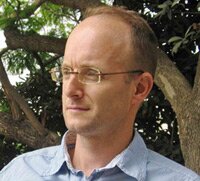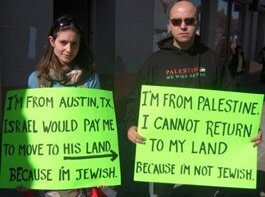Defense Minister Ehud Barak has ordered the demolition of eight Palestinian villages in the South Hebron Hills because the territory is needed for Israel Defense Forces training exercises, the state told the High Court of Justice on Sunday… The IDF and the Civil Administration regard all of them as squatters in Firing Zone 918, even though the villages have existed since at least the 1830s.
IOA Editor: Since the early 1950s, “military training needs” has been a commonly used justification for the removal of Palestinians from lands desired by Israel. Typically, after a period of time, lands captured by this method have been turned over for Jewish settlements. As commented here before, this is an old “legal” tool used by the state to deprive Palestinians of their land and livelihood, which is part of a much larger program: the ethnic cleansing of Palestine — the replacement of the indigenous Palestinian population by a new, Jewish-only population — bit by bit, year after year, decade after decade, “dunam here and dunam there,” as the old Zionist slogan goes.
By Amira Hass, Haaretz – 23 July 2012
www.haaretz.com/news/diplomacy-defense/israel-orders-demolition-of-8-palestinian-villages-claims-need-for-idf-training-land.premium-1.453015
Residents of targeted villages will be moved to the West Bank town of Yatta and its environs; state claims that most of those evacuated have permanent homes in the area.
Defense Minister Ehud Barak has ordered the demolition of eight Palestinian villages in the South Hebron Hills because the territory is needed for Israel Defense Forces training exercises, the state told the High Court of Justice on Sunday.
The residents of the targeted villages will be moved to the town of Yatta and its environs; the state claims, based on information it obtained from local informers, that most of these people have permanent homes in that area.
The state will allow the residents to work their lands and graze their flocks there when the IDF is not training — on weekends and Jewish holidays – and during two other periods of one month each during the year. Barak agreed to leave four villages that are in the northernmost part of the area, even though this would reduce the dimensions of training area and prevent the use of live fire.
The villages slated for demolition are the larger villages in the region: Majaz, Tabban, Sfai, Fakheit, Halaweh, Mirkez, Jinba, and Kharuba, which have a total of 1,500 residents. The villages to be spared are Tuba, Mufaqara, Sarura and Megheir al-Abeid, which have a total of 300 residents.
The IDF and the Civil Administration regard all of them as squatters in Firing Zone 918, even though the villages have existed since at least the 1830s.
Evacuation orders were issued against the 12 villages in 1999, but were frozen by an injunction issued by the High Court of Justice in response to two petitions that were united: One by attorney Shlomo Lecker and the second by the Association for Civil Rights in Israel, who together represented some 200 families. An effort to reach an agreement on the status of the residents in the area by a mediation process failed in 2005.
At that point, the Civil Administration started to issue demolition orders against cisterns and restrooms that several families had added, claiming that these additions violated the status quo as set by the court. This past April, after 12 years of various proceedings and delays, the High Court held a preliminary hearing on the petitions, with the state submitting its final position on Sunday.
Attorney Hila Gurani, a senior deputy state prosecutor, wrote in the response to the petitions that the IDF has been forced to limit its military exercises in the area because of the people living there and the illegal construction that has taken place there. For the same reason, no live-fire training is conducted there.
In addition, wrote Gurani, during the second intifada, operational activity came at the expense of training, but the Second Lebanon War exposed weak spots that substantially increase the need for training and firing zones. Gurani also noted that there was a risk that residents of the firing zone would collect intelligence on IDF methods, or take weapons or equipment that the forces might leave behind, and use them for terror purposes.
The village residents, ACRI and the B’Tselem human rights group present the issues differently. According to them, all 12 villages were natural outgrowths of cave-dwelling communities that are widely found in that area. In some of the villages, homes of unchiseled stone were built even before 1967.
The connection to Yatta is natural – and characteristic of many satellite communities that developed over the centuries in historic Palestine. For generations the cave-dwellers were farmers and shepherds, producing milk and cheese, and they have preserved their way of life to this day, while integrating into Yatta as a result of contemporary demands, such as the need to send their children to school.
The IDF had declared some 30,000 dunams (7,500 acres) in the area a closed military zone back in the 1970s. Under military law, only permanent residents are allowed to remain in a closed military zone.
Until 1997, the cave-dwellers continued to live in their communities undisturbed – which the petitioners say is clear evidence that they were regarded at the time as permanent residents. However, as happened in much of the West Bank that under the Oslo Accords was deemed Area C – under complete Israeli control – the Israeli authorities did not allow the residents to build more structures, including schools or clinics, to accommodate their natural growth. These communities were not included the master plans that were prepared for the building of the area settlements, and thus to this day these villages are not connected to the road system, the water system or to the electrical grid.
In August and November 1999, most of the area’s residents received eviction orders due to “illegal residence in a firing zone.” On November 16, 1999, the security forces forcibly evicted more than 700 residents, and the IDF demolished buildings and wells and confiscated property, leaving the residents with no homes and no livelihood.
As noted, the High Court, in response to the petitions, issued an interim injunction, allowing the villagers to temporarily return to their homes. However, because the army had destroyed many of the buildings, many residents had nothing to return to. Moreover, the security forces interpreted the interim injunction as narrowly as possible, allowing reentry only to the named petitioners and denying access to their relatives.
As a result, the examination conducted by the Civil Administration that is quoted in the state’s response to the court on Sunday found that in 2000 “there were no permanent residents in the area,” and that anyone living there was there only on a seasonal basis. On the other hand, the Civil Administration identified most of the petitioners as living in and around Yatta, as reported in the affidavit of Raziel Goldstein, who was the Civil Administration’s inspection coordinator in the region.
Goldstein also wrote in his affidavit that, “This examination was conducted with the help of three local residents, who were presented with the names of the petitioners and aerial photographs of Yatta.”
The state also claims that in recent years residents have been repeatedly violating the status quo by expanding structures illegally, adding that the number of people entering the area under the interim injunctions is far greater than the number of petitioners.
“The petitioners cannot build on the development of these illegal phenomena and now claim to be talking about permanent residency,” the state wrote.




















